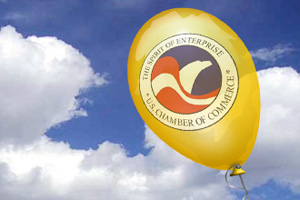
For years, the US Chamber of Commerce overstated its membership numbers by a staggering 900 percent. After Mother Jones debunked its fuzzy math last fall, Washington’s richest lobbying outfit downplayed its claim that it represented 3 million businesses, instead saying that it had a “direct membership” of 300,000 companies. But now it appears that even that number could be overblown by as much as 500 percent. If that’s so, then the Chamber may have to revise its claim to be “the largest business trade association in the country.”
The new numbers come from the union-backed group US Chamber Watch, which examined the Chamber’s 2009 financial disclosures and concluded that it has fewer than 100,000 dues-paying members. Of those, just a handful contribute the vast majority of its annual budget.
Here are the numbers behind US Chamber Watch’s calculations: In 2009, according to forms the non-profit Chamber filed with the IRS, it brought in $205 million. Nearly 94 percent of this, or $193 million, came from slightly fewer than 1,500 members. Assuming that the Chamber has 300,000 members, that means the remaining $12 million of its budget came from 298,500 members giving an average of $40 each. But that doesn’t hold up, since the Chamber’s minimum annual dues are $125 (for an individual membership). If each member paid at that level, the Chamber would have a total of around 100,000 dues-paying members. If each member paid the minimum corporate dues of $250, then the Chamber would have 50,000 dues-paying members. Either way, it’s a far cry from the 300,000 members that the Chamber currently claims.
By citing its impressive membership stats, the Chamber can say that it’s in a league of its own. Yet if it indeed does have around 50,000 paid members, it’s closer in size to groups such as the National Small Business Association, which last year pegged its dues-paying membership at 60,000.
So where did the Chamber get its current membership number from? Most likely from its Federation Partnership Program, in which small businesses that join local chambers of commerce are automatically enrolled in the US Chamber of Commerce free of charge. Local businesses often aren’t aware that they’re members of the US Chamber of Commerce, as I found when I asked green businesses that belong to the San Francisco Chamber of Commerce why they belonged a national group that opposes caps on carbon emissions. After being contacted by several surprised members, the San Francisco Chamber dropped out of the partnership program. As of late 2009, 354 local chambers were participating in the partnership program, though only 17 chambers from the 100 largest cities were involved. Yet the Federation Partnership Program could still be large enough to give the Chamber a 200,000-member boost.
This suggests that the Chamber has been lumping together its dues-paying members with its non-paying affiliates in its membership count. Asked for clarification, Chamber spokesman J.P. Fielder refused to say how many of its businesses pay membership fees.
US Chamber Watch’s analysis of the Chamber’s tax forms also confirms that the group is dominated by a relatively small core of donors. Many Americans still think of the Chamber as a small business group that sponsors little league teams. In reality, it’s a Capitol Hill behemoth; it spent a record-breaking $81.3 million on lobbying this year, plus millions more on political ads. In 2009, only 6 of the 118 members of the Chamber’s board of directors represented small businesses; the rest worked for highly capitalized regional, national, or international corporations. And as Bloomberg reported yesterday, the health insurance industry’s trade organization ponied up 40 percent of the Chamber’s budget last year, a whopping $86.2 million that fueled a massive PR campaign against the Democrats’ health care bill.
Whatever its actual size, the Chamber is continuing to oversell its image as the representative of a broad swath of commercial interests. “For an organization that claims to represent all of American business, the US Chamber’s agenda is increasingly being decided by a group small enough to fit around a smoke-filled board room table,” says US Chamber Watch spokeswoman Christy Setzer. “That’s bad for democracy, bad for Chamber members, and certainly bad for business.”












